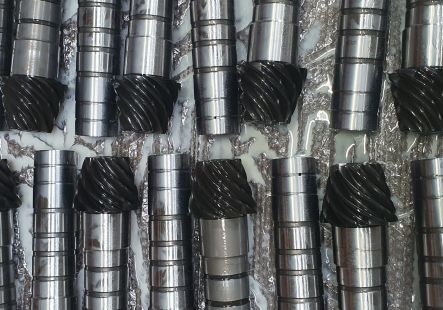We use the following phosphating production lines with counter-current rinsing:
- Mn-Ph Manganese phosphating production line
- Zn-Ph Zinc phosphating production line
Phosphating (also known as phosphatisation) is a chemical process in which a coating is formed on a clean, metallic (usually steel) surface. The coatings formed by phosphating are not electrically conductive, reducing the amount of corrosion. Phosphates are not soluble in water or organic solvents and are very compatible with base metals.
Our phosphating adheres to EN 12476 and ISO 9717 standards. It is a fine to medium-grained phosphate in structure manganese.
The maximum size of the phosphated part is 1.5 x 1.5 x 1.7 m (width/width/height) and the maximum weight of the part is 5 tonnes.
The crystalline phosphate layers formed during phosphating perform several important functions:
- create good corrosion protection for metal components.
- improve lubricant adhesion when cold forming steel objects, e.g. before pipe drawing to the surface and reduce friction
- before painting, to improve the adhesion of the coating to the metal surface and prevent rusting coatings
- reduce friction - used to treat moving metal machine parts while running
- serve as electrical insulators
Phosphating as corrosion protection
Phosphating in conjunction with impregnation is used to protect mass-produced machine parts against corrosion. In addition, the crystalline nature of the phosphate layer allows it to bond much more of the impregnating agent onto the surface. The amount bonded is greater the thicker the phosphate layer. In the final stage, we impregnate the phosphate layer with oil, petroleum jelly or waxes.
Phosphating before cold forming of metals
In this application, the phosphate layer, along with suitable lubricants, acts as an intermediate layer to reduce friction between the tool and the product to be formed. In order to transform the phosphate layer into a layer with the required lubricating properties, the phosphated articles must be immersed in a hot detergent solution. The phosphate layer absorbs the detergent and also reacts with it to form an insoluble zinc soap.
Phosphating prior to paint application
A phosphate layer creates corrosion resistance of the painted phosphated surface, preventing the coating from "under-rusting" and increases its adhesion to the metal surface.
In terms of corrosion protection, a thick phosphate layer would be most effective. However, such thick coatings lead to the release of individual crystals and thus to paint chipping. It is therefore recommended that the thickness of the phosphate layers be as small as possible.
Phosphating moving parts before breaking-in
This technology is designed to facilitate the period where it’s necessary to break in moving machine parts.The main phosphating component contains manganese and forms a layer of phosphate on the steel surface. Manganese has a higher hardness rating than conventional phosphate layers containing zinc, and its different crystalline structure enables a higher level of oil absorption. The phosphate layer reduces break-in time, reduces component wear and reduces engine noise.




